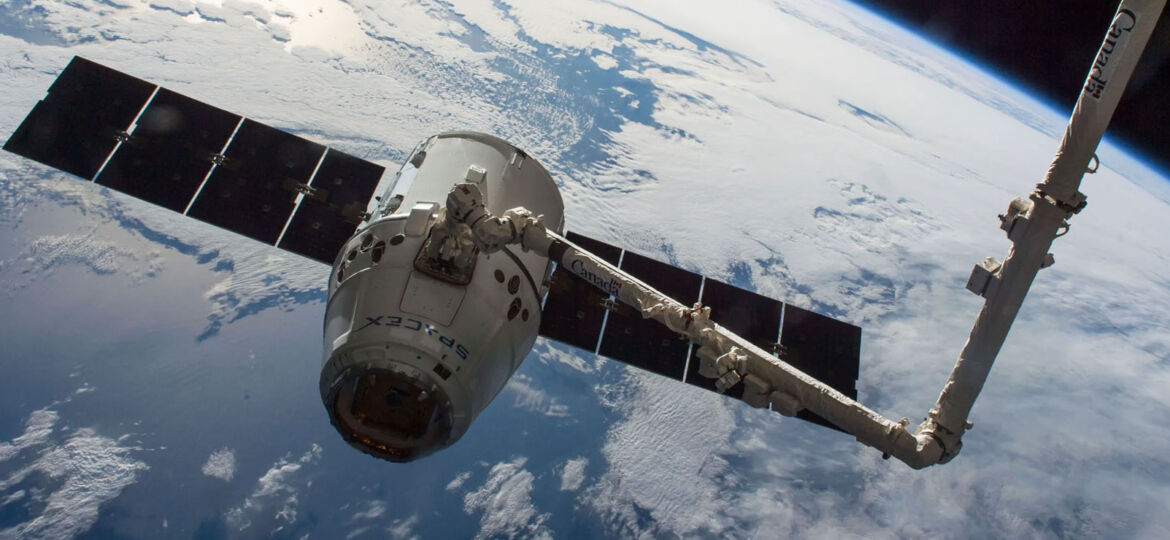
WHY THIS MATTERS IN BRIEF
One of Elon Musk’s ambitions is to allow people to live off world, but first you have to get them there and this is the first step in a long journey.
SpaceX’s Dragon spacecraft, which Elon Musk first showed off a few months ago, splashed down safely in the Atlantic yesterday after its first return flight to the International Space Station (ISS), and in doing so it successfully completed its first test mission, and moved SpaceX a huge step closer to another of its goals to fly tourists and astronauts into space.
While there were no people on board the craft it was specifically built to carry four NASA astronauts to the ISS, and the nearly week long return journey culminated when the craft disembarked from the station about 2:30 AM Friday, fired its engine to slow down, and barrelled through the thickening atmosphere at hypersonic speeds on its fiery return to Earth until it finally splashed down in the Atlantic Ocean at 8:45 AM where it was then hoisted out of the water and placed on the deck of a recovery boat shortly before 10 AM.
Crew Dragon is on SpaceX’s recovery vessel—completing the spacecraft’s first test mission! pic.twitter.com/6K0qgnHd4O
— SpaceX (@SpaceX) March 8, 2019
The nail biting mission comes at a precarious time for brash billionaire Elon Musk, SpaceX’s founder and CEO, who has come under fire for his sometimes erratic behaviour. The re-entry especially was also one of the company’s biggest tests as Musk and SpaceX set their eyes on not just manned space flight, but also colonising Mars, and if the flight’s deemed a complete success, which it looks likely it will, then the mission will boost NASA’s confidence in one of its prime contractors and propel the space agency a step closer to restoring human spaceflight from US soil.
Since the space shuttle was retired in 2011, NASA has been unable to fly its astronauts, and instead has had to pay Russia for rides to the space station at an increasing price tag that now tops $80 million a ride.
In 2014, NASA awarded contracts worth a combined $6.8 billion to SpaceX and Boeing to build spacecraft capable of carrying NASA’s astronauts to the orbiting laboratory 250 miles above Earth. Since then, both companies have faced delays and setbacks, but now, SpaceX has taken a major leap forward and is poised to fly its first manned test mission with two NASA astronauts on board later this year, while Boeing is scheduled to fly its first un-crewed mission to the station by next month at the earliest, although that date is likely to slip, officials have said.
SpaceX’s un-crewed mission began early last Saturday, when its Falcon 9 rocket blasted off in the predawn darkness from a historic launchpad at the Kennedy Space Center in Florida, where the crew of Apollo 11 began their journey to the lunar surface.
Once aloft, the SpaceX craft travelled to the ISS, whizzing around Earth at 17,500 mph, catching up early the next morning. Before the mission, NASA officials had said the spacecraft’s ability to dock autonomously to the station would be one of the biggest tests of the vehicle.
Russia meanewhile, one of NASA’s key partners on the space station, initially objected to the test flight, citing concerns about the SpaceX computer system that would fly the vehicle toward the station. But like the launch, the docking was a success, and soon the three astronauts on board the station — NASA’s Anne McClain, Oleg Kononenko of Russia, and Canada’s David Saint-Jacques — were able to check out the first commercial space vehicle designed for human space flight ever to dock with the station.
In a call with the astronauts on board the station Wednesday, US Vice President Pence said, “It was inspiring to see the launch, and it was actually more inspiring to see the docking, and to see you all open that door and float into that spacecraft knowing that we’ll very soon have American astronauts arriving at the International Space Station in the same vehicle.”
The successful landing is a coup for SpaceX and a relief for Musk, who said he wouldn’t be able to relax until the spacecraft had landed safely.
Musk and his companies have been under scrutiny lately. The Securities and Exchange Commission fined him $20 million last year after it said he misled investors of his electric car company, Tesla, when he tweeted that he would take the company private. More recently, the SEC claimed he violated the terms of the settlement, which require an attorney to review tweets that could affect Tesla’s stock price, and a judge in that case gave Musk until Monday to say why he should not be held in contempt for violating the terms of the settlement.
Musk has also faced trouble at SpaceX. The Air Force recently announced it was reviewing the certifications it had granted SpaceX that allow to launch national security payloads after Musk smoked marijuana during a podcast appearance, while NASA announced it was conducting a safety review of both SpaceX and Boeing. Then Bloomberg News reported Thursday that Musk’s marijuana use also prompted the Pentagon to review his security clearance.
Despite the distractions though Friday’s landing appeared to be another triumph for SpaceX, and validation of years of work. Leading up to the reentry, Musk had said he was worried about whether the spacecraft would end up in an uncontrollable spin.
The Dragon is outfitted with abort thrusters that make the spacecraft asymmetrical, which he said “could potentially cause a roll.” But he said he thought it was “unlikely” since the company had run “simulations a thousand times.”
Still, he added “hypersonic re-entry is probably my biggest concern.” And it turned out it was a concern that was in the end thankfully unfounded.
















